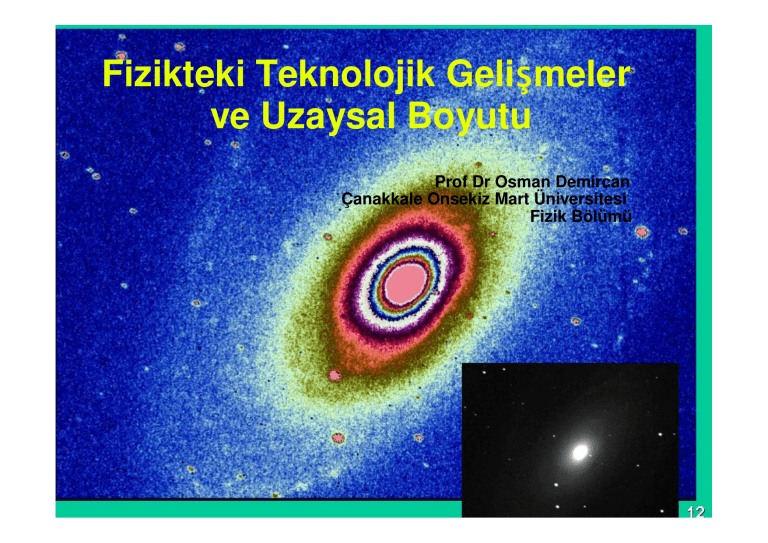
Fizikteki Teknolojik Geliş
şmeler
ve Uzaysal Boyutu
Prof Dr Osman Demircan
Çanakkale Onsekiz Mart Üniversitesi
Fizik Bölümü
Parçacıklar
Kümelenme özellikleri
Beş temel kuvvet
Hızlandırıcılar
Evrendeki yapılar
Uzağı iyi görme
Teleskop ve dedektör teknolojisi
Büyük teleskoplar
ÇOMÜ teleskopları
Bazı gözlem sonuçları
Energy in the universe
1 electronvolt (eV) = 1.602 × 10−19 J
4.37 × 10−21 J
Average kinetic energy of a molecule at room temperature
3.2 × 10−11 J
total energy released in fission of one U-235 atom
3.2 × 10−11 J
ion collision energy level of the Large
Hadron Collider CERN (2005).
1.74 × 1017 J
Total energy from the Sun that hits the Earth in one second
1 × 1044 J
The energy released from a supernova
1 × 1047 J
The energy released in a gamma ray burst
1 × 1070 J
Theoretical total mass-energy of the universe
(the largest known energy level)
1 Cal = 4.184 J
Magnetic fields in the universe
~1Gauss
~5G
~1000 G
~1000 G
1 000 000 G
1 000 000 000 000 G
1 000 000 000 000 000 G
Earth's field at ground level
Solar surface field
Sun spot field
Jupiter magnetic field
White Dwarf star surfaces
Neutron star surface field
Magnetar field
Temperatures in the universe
14 K
295 K
373 K
5780 K
15 000 000 K
100,000,
000,000,000,
000,000,000,
000,000,000 K
melting point of bound hydrogen
room temperature
boiling point of water
Sun (surface)
Sun (center)
Acoording to bing bang (t=10-43)
Teleskop Türleri
Νötrino teleskopları
γ-Işın Teleskopları
X-ışın Teleskopları
Moröte Teleskoplar
Optik Teleskoplar
Kırmızıöte Teleskoplar
Radyo Teleskoplar
Optik Teleskoplar
Mercekli teleskoplar
Aynalı teleskoplar
Katadioptik (Mercekli-Aynalı) teleskoplar
Mercekli Teleskoplar
Aynalı Teleskoplar
Newtonian türü aynalı teleskoplar
Cassegrain türü aynalı teleskoplar
Newtonian Teleskoplar
Cassegrain Teleskoplar
Teleskop Kurguları
Alt-azimut Kurgu
Eşlek Kurgu
Alman Kurgu
Çatal Kurgu
Astronomy exposes you to both the smallest (atomic!) and largest
(observable universe: 14 billion light years > 1025 m!) sizes
Gökcisimlerin fiziksel parametrelerini
nasil buluruz?
•
•
•
•
•
•
Kütle
Yarıçap
Sıcaklık
Enerji
Uzaklık
Yaş
Kütle ?
Galaxy-galaxy
star-planet
star-star
Light Curve (LC)
shows the brightness
of the object over a
period of time.
t
es
l
e
pe
o
c
periodic
aperiodic
(eclipsing
binaries,
cepheids)
(CVs and
supernova)
Radial Velocity (RV) curve
lin
e
of
t
h
g
si
RV of star can be
measured accuratly by
taking its spectrum.
radial velocity = ( shift * speed of light) / (rest wavelength)
Stars in clusters
A quasar may readily release energy
in levels equal to the output of
hundreds of average galaxies
combined. In optical telescopes, a
quasar looks like a very faint star
(i.e. it is a point source), and has a
very high redshift. The general
consensus is that this high redshift is
cosmological, the result of Hubble's
law, which implies that quasars must
be very distant and hence very
luminous.
The densest objects
in the Universe
The gamma-ray universe
Gamma-ray bursts (GRBs) are the
most luminous physical phenomena in
the universe known to the field of
astronomy. They consist of flashes of
gamma rays that last from seconds to
hours, and may be followed by several
days of X-ray, ultra violet or optical
afterglow.
The Age of the Universe &
The Hubble Law
• The relationship between velocity and distance is: v = H 0 × D
If the universe has been expanding uniformly, the
time for this is:

